15 Most Common Types of Butterflies in Kentucky (With Pictures)
-

- Last updated:
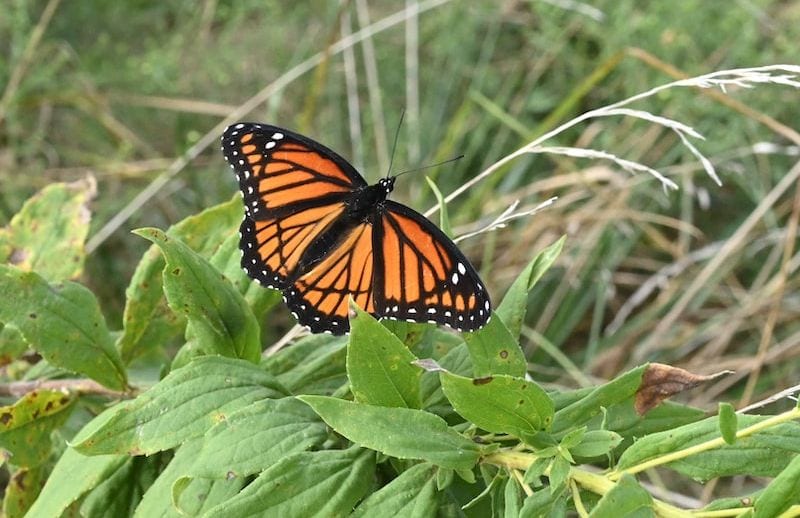
The state of Kentucky is home to a wide range of butterfly species. Kentucky has butterflies in the Central Hill and Valley area, the Cumberland Mountain area, the Blue Grass Section, the Shawnee Hills, and along the western part of the Mississippi River.
We have compiled a list of 15 of the most recognizable butterflies in the Bluegrass state, including the viceroy, the state butterfly of Kentucky.

The 15 Most Common Types of Butterflies in Kentucky
1. The Viceroy Butterfly

| Species: | Limenitis archippus |
| Wingspan: | 2.1–3.2 inches |
| Coloring: | Orange and black |
The viceroy butterfly is orange and black and resembles the monarch butterfly. However, a black line on the bottom of the wing on the viceroy distinguishes it from the monarch butterfly.
The caterpillars of the viceroy butterfly are dramatically different from those of the monarch. The viceroy caterpillars are less attractive than those of the monarch.
The viceroy butterfly is the state butterfly of Kentucky and one of the prettiest in the entire state. The caterpillars are sometimes called the “ugly ducklings,” however.
2. The American Painted Lady Butterfly
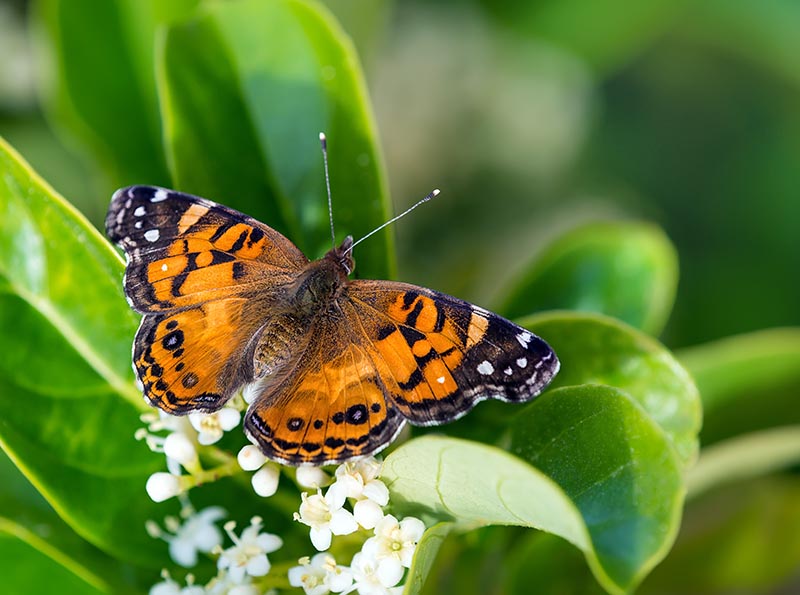
| Species: | Vanessa virginiensis |
| Wingspan: | 2 inches across |
| Coloring: | Vibrant orange, dark markings, white and purple spots |
The American painted lady can be found in landscapes with flowering, leafy plants. The American lady is an anxious butterfly that will fly away at the slightest hint of a disturbance, however.
The butterfly is easily identified by the eyespots on the underside of its wings. The marks are circular and meant to intimidate and ward off predators.
The American painted lady and the painted lady can be distinguished by the differences in their wings. The hind wings of the American painted lady have black dots with blue centers. The wings of the painted lady have a few small black dots on the hind wings.
3. Red Admiral Butterfly
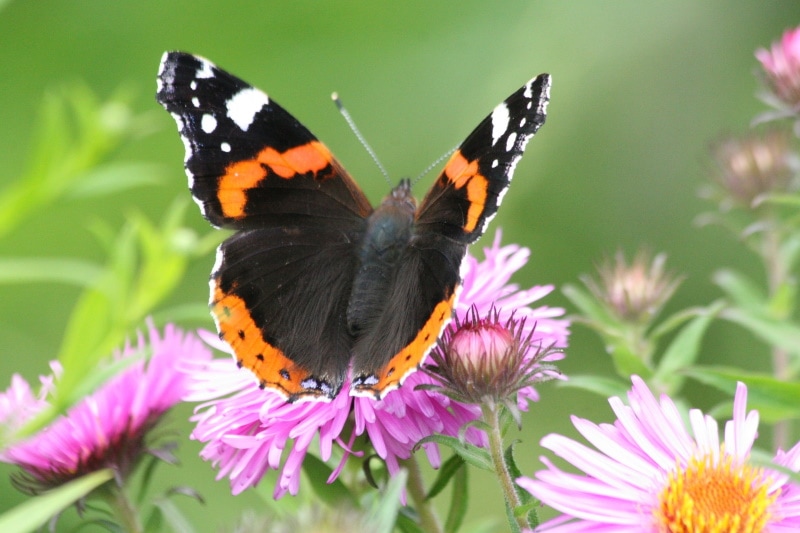
| Species: | Vanessa atalanta |
| Wingspan: | 1.75–2.5 inches |
| Coloring: | Deep brown, reddish circular band, white spots |
The red admiral can be found in habitats that are moist and near forests. They love to eat sugary fruit. They are sure to have a feast if you place an overripe strawberry or banana in your yard on a sunny day.
Red admirals will migrate up north in the late spring and move to the south during the winter months.
This butterfly can easily be observed since it is calm and approachable. They are also known to be comfortable landing on humans.
4. The Monarch Butterfly
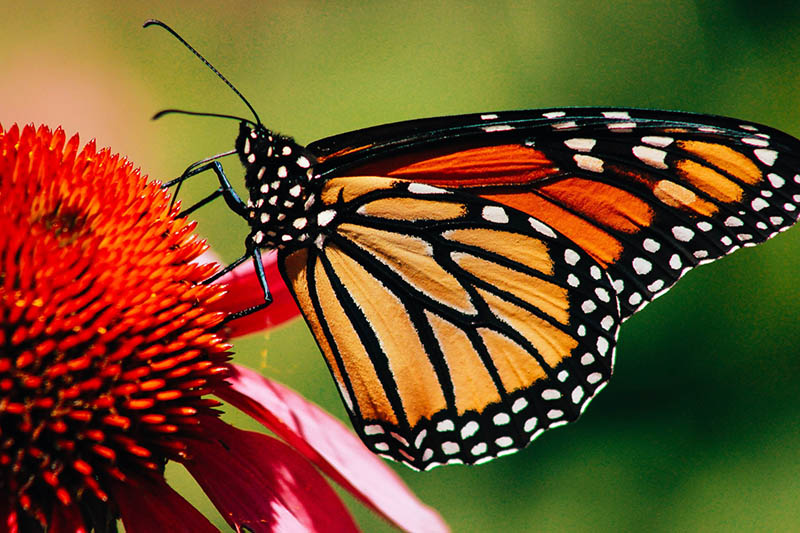
| Species: | Danaus plexippus |
| Wingspan: | 3.5–4 inches |
| Coloring: | Orange, black veins, white dots on the perimeter of wings |
The monarch butterfly is one of the most recognizable butterflies in Kentucky and in the world. They are sometimes called “stained glass” due to their coloring and pattern.
Like bees and other pollinating insects, the overall population of the monarch butterfly is on the decline. Since milkweed is their food of choice, planting some in your yard will help to attract this beauty along with other pollinators. You will not only help to save the monarch population, but you will also be able to enjoy the beautiful species all summer long. Once the colder weather starts to set in, they will fly south in groups of hundreds around mid-September and return to the north again in the spring.
5. The Painted Lady Butterfly
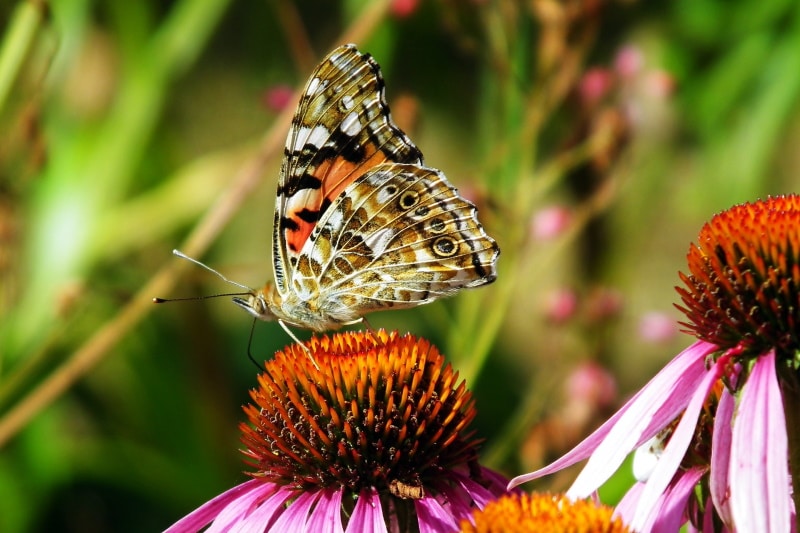
| Species: | Vanessa cardui |
| Wingspan: | 1.75–2.5 inches |
| Coloring: | Pinkish-orange, black, or brown marking with white spots on wing tips |
Unfortunately, the painted lady is not a social butterfly. They like quiet, inactive areas like gardens, pastures, and undisturbed roadsides. This migrator stays in the north during the spring and summer months and quickly heads south to Mexico in the winter.
The painted lady population varies from year to year. There are places where they are non-existent for years then, out of nowhere, they reappear in significant numbers.
Since the painted lady migrates to a warmer climate during the winter months, she is the only butterfly that mates and hatches her eggs all year long.
6. Red-Spotted Purple Butterfly
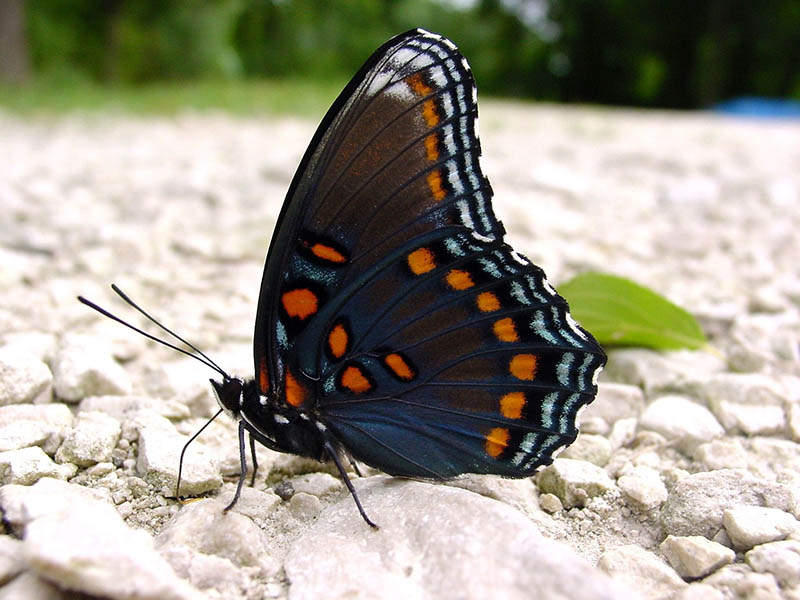
| Species: | Limenitis arthemis astyanax |
| Wingspan: | 3–4 inches |
| Coloring: | Blackish-blue, orange, and red spots and sometimes light blue spots on wings |
The red-spotted purple is a beautiful butterfly that will catch your eye. They have shimmery wings of dark purple with red-orange spots. The color of the wings is like a pipevine swallowtail butterfly and this is what keeps them safe from birds. Predators will mistake them for the poisonous pipevine swallowtail butterfly and leave them alone.
Not all red-spotted purples look the same, however. In northern areas, the butterfly is referred to as the white admiral because its coloring is completely different from the dark purple butterfly, and it lives in areas like Pennsylvania, Maine, and Minnesota. These areas do not have pipevine swallowtails either.
These butterflies prefer to feed on rotting fruit, sap, and carrion instead of nectar. From spring to early fall, you can place some fruit like bananas or oranges in your yard for the lovely butterfly to feed on.
7. Hackberry Emperor Butterfly
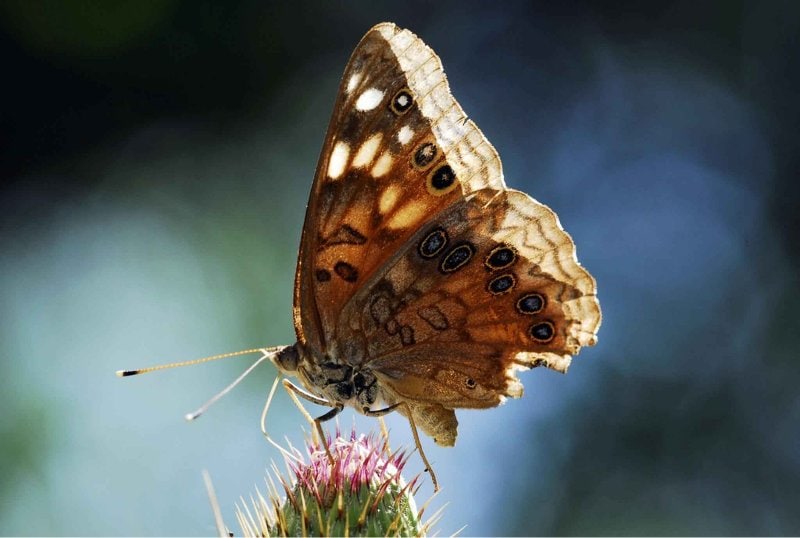
| Species: | Asterocampa celtis |
| Wingspan: | 2–2.75 inches |
| Coloring: | Patterned, amber brown, nearly black with orange eyespots, deep brown, and white spots |
The hackberry emperor is a common butterfly in the state of Kentucky. They can be found in parks, yards, and wooded areas. They will not be found on flowers, however. They have a curiosity about flowers, but they do not feed on them.
The hackberry emperor is not fond of the nectar in flowers and survives on the minerals from the soil, pavement, rocks, and salt on human skin. They are not picky butterflies; they will drink water from puddles and will also eat dung, carrion, rotting fruit, and sap.
8. Pearl Crescent Butterfly
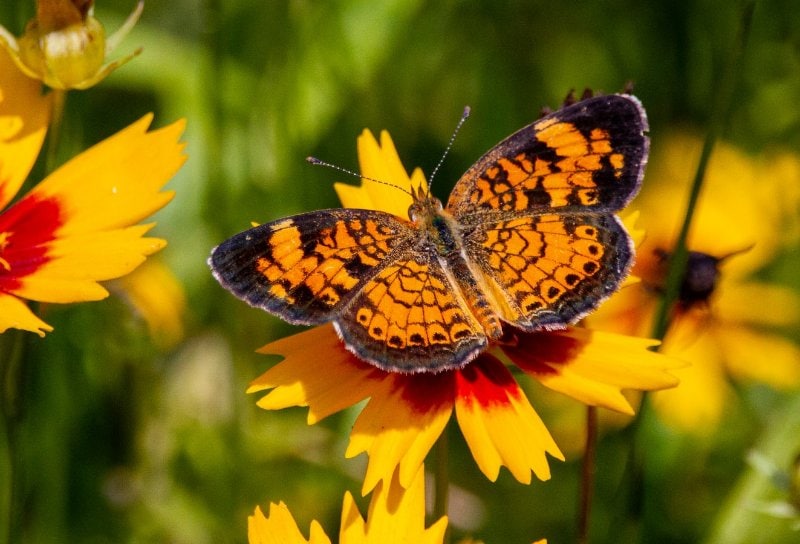
| Species: | Phyciodes tharos |
| Wingspan: | 1.25–1.75 inches |
| Coloring: | Vibrant orange with black borders, lines, and spots. The pattern looks like lace |
To attract this butterfly to your garden, plant some flowering trees and bushes that are native to your area. The pearl crescent butterfly and the caterpillar love the nectar of the aster plant, however. However, most flowering plants will suffice if an aster is not nearby.
The pearl crescent is a common butterfly in Kentucky and likes moist and sunny habitats. They can be found in fields, meadows, gardens, and the edge of forests.
9. Aphrodite Fritillary Butterfly
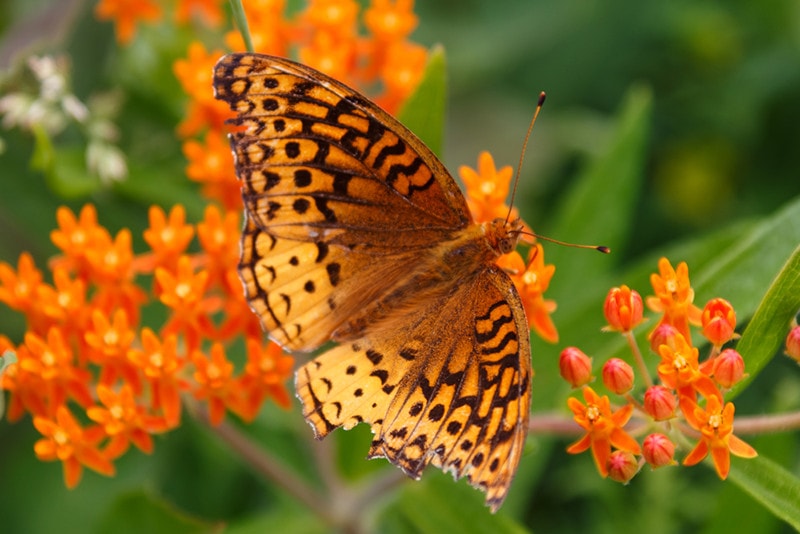
| Species: | Speyeria aphrodite |
| Wingspan: | 2–3 inches |
| Coloring: | Yellow-orange, black webs, and dots, bluish-white dots with black rings on the underside of the wings |
If you would like to attract the Aphrodite fritillary to your garden, plant some violets. Not only are they attracted to the violet plant, but they will also lay their eggs nearby. Once the eggs hatch, the caterpillars will hibernate in the violet plant. Other plants that will attract the Aphrodite fritillary are butterfly weed, thistles, goldenrod, and milkweed.
In the state of Kentucky, check out meadows, pastures, and fields to get a look at these attractive butterflies.
10. Spring Azure Butterfly
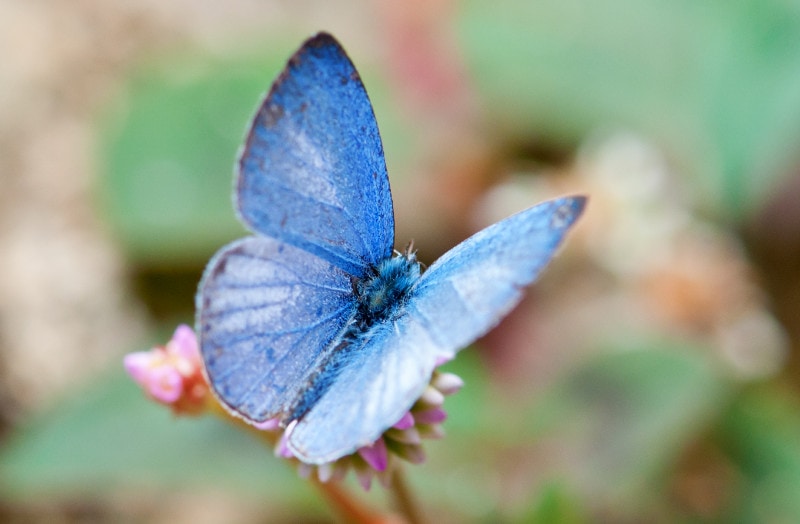
| Species: | Celastrina ladon |
| Wingspan: | .75–1.25 inches |
| Coloring: | The coloring ranges from cornflower blue to gray, with shades of gray stripes and spots |
From the roadsides to the edge of forests, this attractive bluish-gray butterfly can be found when you are walking or hiking on a trail or enjoying a picnic in a wooded area. The population of the spring azure butterfly has large ranges, and they are widely seen in the state of Kentucky.
Part of the beauty of the azure is due to the wings. The gossamer wings are like a delicate and light fabric with edges that appear to be frayed or fringed. However, the female azure tends to be darker and less colorful than the lighter-colored males.
There are three other azure species—the Appalachian azure, the summer azure, and the dusky azure—that can be found in Kentucky.
11. Black Swallowtail Butterfly
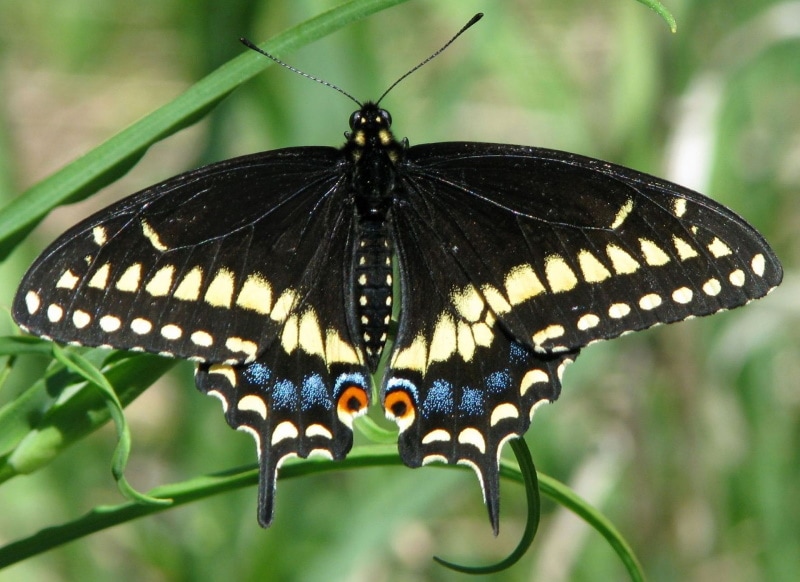
| Species: | Papilio polyxenes |
| Wingspan: | 2.5–4.25 inches |
| Coloring: | Black with yellow spots, each hind wing has one red-orange spot and blue spots |
If you have an herb garden in Kentucky, you may have black swallowtail caterpillars hanging around. They love to use herbs as host plants, so keep an eye on your mint and parsley. If you notice some beautiful black swallowtails hanging around, check your garden. The caterpillars can overfeed on your plants and harm them. The butterflies love to drink on garden plants and will feed off the garden nectar, however.
Like the red-spotted purple butterfly, black swallowtails will mimic the markings of the poisonous pipevine swallowtail so they can hide from predators.
In addition to the black swallowtail, some of the most common swallowtails in Kentucky include the spicebush, the eastern tiger, and the zebra.
12. Cabbage Whites Butterfly
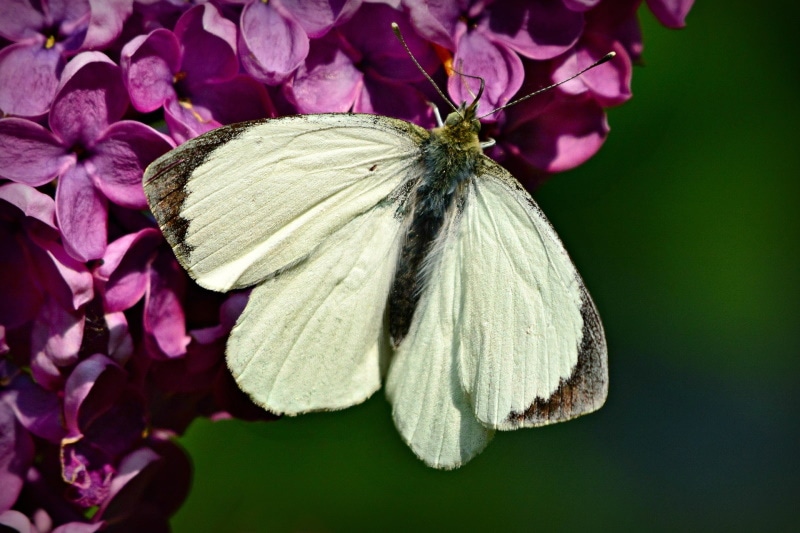
| Species: | Pieris rapae |
| Wingspan: | 1.5–2 inches |
| Coloring: | Greenish to white color, black wing tip and dot on the center of the wings |
Cabbage whites are popular butterflies that can be seen anywhere except in the thick forest. They breed and are most active in the summer months. If you see them in your garden, be on the lookout for damage to your plants.
Cabbage white butterflies were brought to Kentucky through trade and are considered one of the most damaging and invasive species in the state.
The caterpillars of the cabbage whites are called cabbage worms. Gardeners are familiar with this pest since they invade their gardens and feed off their plants. They can do quite a bit of damage to brassica plants like cabbage and kale.
13. American Copper Butterfly
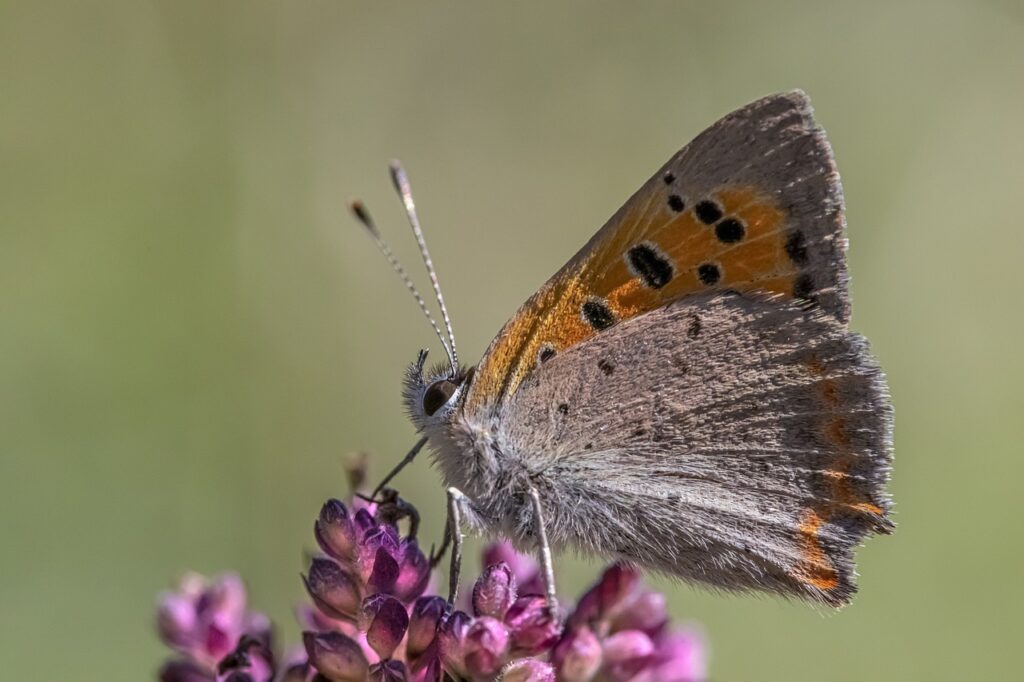
| Species: | Lycaena phlaeas |
| Wingspan: | .75–1.5 inches |
| Coloring: | Orange upper wings with a gray border and black spots, lower wings are gray in the middle with an orange and black border, black flecks on the gray underside of the wings |
This is a climate-friendly butterfly that can adapt to hot and humid weather and cold winters. They are usually active from June to September. If the area is warm, the active season can be longer, however.
The American copper can be frequently seen in areas with gardens that have butterfly weed and hawkweed, a favorite for the adult butterfly.
Among others, you may hear this species referred to as common coppers or little coppers. They are widespread, so their name will depend on the region.
14. Coral Hairstreak Butterfly
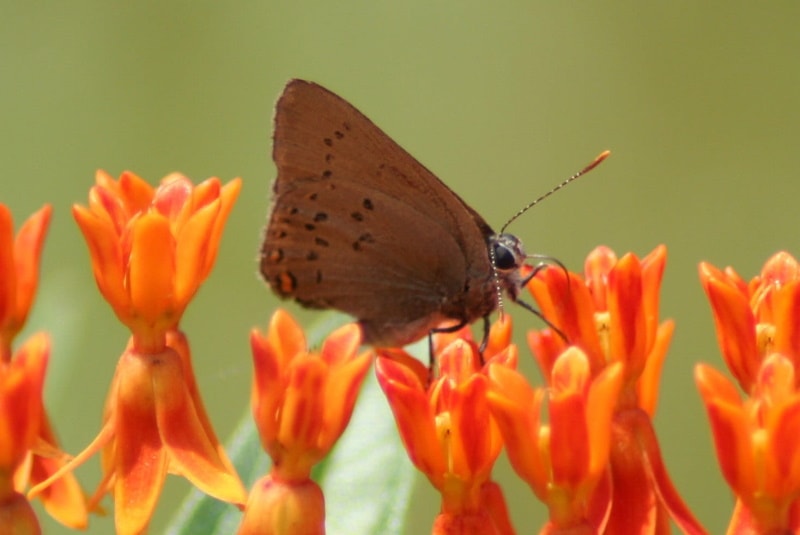
| Species: | Satyrium titus |
| Wingspan: | .9–1.25 inches |
| Coloring: | Grayish-brown, one set of coral spots with black rings and one set of black spots with white rings |
Due to the small, colorful body of the coral hairstreak, it is one of the most unique and recognizable butterflies you will see in Kentucky.
They like to perch on milkweed blossoms and feast on the nectar of the flower. They can be found near the edges of woodlands and fields with lots of brush.
As for the caterpillars of the coral hairstreak, they like to feed on American plum and wild cherry trees.
15. Silver-Bordered Fritillary Butterfly

| Species: | Boloria selene |
| Wingspan: | 1.6–2.1 inches |
| Coloring: | Bright orange, black markings, irregular patterns, wings have white edge and thick black border with orange dots, wings have metallic underside with silver dots |
The small silver-bordered fritillary is becoming rare in the Bluegrass State. Populations are decreasing due to an increase in agricultural fields. The fields are taking over the wet grasslands, their preferred habit.
Although the populations are decreasing, the nectar from the thistle flower will attract the ones that are in the area. The caterpillars will also enjoy some violet plants if you are interested in planting them to attract the insects into your garden.
Keep your head down if you want to catch a glimpse of one of these rare beauties, however. They are known for flying close to the ground. This Fritillary does not glide gracefully, however. Their movements are fast and jerk-like.

Conclusion
From caterpillars to beautiful butterflies, we have listed 15 of the most common types of butterflies in Kentucky. There are at least 59 species of these insects that inhabit the state during a particular season or all year long. Butterflies are beautiful, diverse, and loved by humans everywhere.
So, if you want to create a butterfly haven in your garden, add some plants like violets or milkweed that will attract these fascinating insects. Catching a glimpse of a monarch, azure, or black swallowtail while drinking your morning coffee may make your day a little brighter.
- Related Read: 20 Types of Butterflies in Minnesota (with Pictures)
- https://en.wikipedia.org/wiki/American_lady
- https://birdwatchinghq.com/butterflies-in-kentucky/
- https://en.wikipedia.org/wiki/Viceroy_(butterfly)
- https://en.wikipedia.org/wiki/Monarch_butterfly
- https://en.wikipedia.org/wiki/Vanessa_cardui#Description
- https://en.wikipedia.org/wiki/Asterocampa_celtis
- https://en.wikipedia.org/wiki/Pearl_crescent
- https://en.wikipedia.org/wiki/Aphrodite_fritillary https://en.wikipedia.org/wiki/Celastrina_ladon
- https://en.wikipedia.org/wiki/Swallowtail_butterfly
- https://en.wikipedia.org/wiki/Papilio_polyxenes
Featured Image Credit: J Dean, Unsplash
Contents
